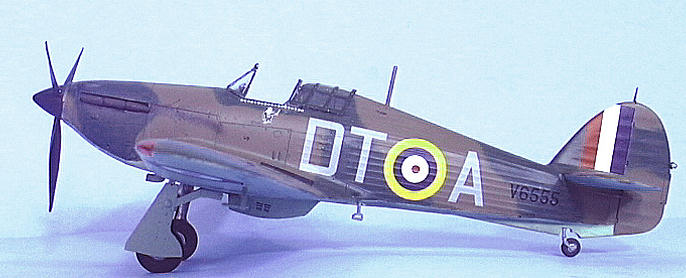
| KIT #: | 09323 |
| PRICE: | Limited Edition, long out of production |
| DECALS: | Two Options |
| REVIEWER: | Tom Cleaver |
| NOTES: |
Aeromaster 48-665
“Early Hurricane Aces of the British Empire 1939-40, Pt. |

| HISTORY |
Robert R. Stanford-Tuck:
Robert R. Stanford-Tuck, with 30 victories one of the top RAF aces of
the Second World War, joined the RAF in 1935 at age 19 on a short service
commission, following two years at sea as a cadet
Tuck did not at first take to flying, and was nearly “bowler-hatted”
for not soloing until he had 14 hours.
From there on it was “tea and biscuits” as they say.
After training on the Avro Tutor, Hawker Hart, Hawker Fury and the
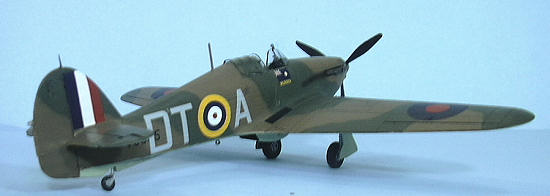 Posted to 65 Squadron at Hornchurch in July 1936, Tuck flew Demons
until they were replaced at the end of the year with Gloster Gauntlets,
followed in late 1937 by Gladiators. During this period, Tuck was involved
in a mid-air collision during formation aerobatics training, and again came
close to being kicked out of the service, but was found not to have been at
fault in the accident. Shortly
thereafter, 65 Squadron re-equipped as the second squadron to use the
Spitfire I shortly after the
Posted to 65 Squadron at Hornchurch in July 1936, Tuck flew Demons
until they were replaced at the end of the year with Gloster Gauntlets,
followed in late 1937 by Gladiators. During this period, Tuck was involved
in a mid-air collision during formation aerobatics training, and again came
close to being kicked out of the service, but was found not to have been at
fault in the accident. Shortly
thereafter, 65 Squadron re-equipped as the second squadron to use the
Spitfire I shortly after the
By the outbreak of war in September 1939, Tuck had several hundred
hours on Spitfires. Confined to
the
With the British Expeditionary Force forced to retreat to
 92 Squadron was in 11 Group, and over the summer Tuck took part in
numerous combats over the Channel.
His combat success continued: a shared Do17 on July 8th; a
damaged Ju88 on July 25th; a shared Ju88 on August 13th
and two destroyed Ju88’s on the 14th. On August 18th,
Tuck attacked a group of Ju88’s over
92 Squadron was in 11 Group, and over the summer Tuck took part in
numerous combats over the Channel.
His combat success continued: a shared Do17 on July 8th; a
damaged Ju88 on July 25th; a shared Ju88 on August 13th
and two destroyed Ju88’s on the 14th. On August 18th,
Tuck attacked a group of Ju88’s over
On September 11th, at the height of the
On September 23rd Tuck claimed another Bf-109, a Ju88 on
October 4th a Bf109 on October 12th and a Bf-109 and
two damaged on October 25th. His final victories in the
Tuck remained with 257 Squadron until May, 1942, when he was promoted
to Wing Commander and given command of the Duxford Wing.
That October he was taken off operations after more than a year of
steady combat and sent to the United States to tour American flight training
schools and lecture on air combat.
He also flew all of the American fighters as part of an Air Ministry
assessment program.
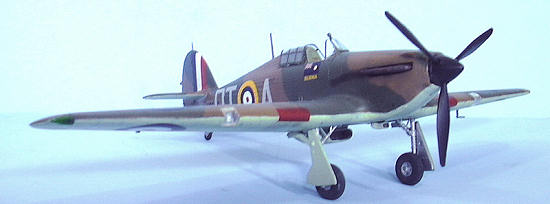 Tuck returned at the end of November 1941 and was given command of
the Biggin Hill Wing, the premiere organization in Fighter Command, a unit
with four Spitfire Squadrons.
On
Tuck returned at the end of November 1941 and was given command of
the Biggin Hill Wing, the premiere organization in Fighter Command, a unit
with four Spitfire Squadrons.
On
In January 1945, as the prisoners in Stalag Luft
Tuck was back in
In 1989, I had the privilege of meeting Wing Commander Tuck when he was brought to the United States by Virginia Bader, niece of Douglas Bader and at the time a well-known gallery owner here in Los Angeles, promoting aviation art. Tuck came with Johnny Johnson, who turned out to be as condescending to “colonials” as I had been told he was by a couple of old RCAF pilots who had served under him. “Bob” Tuck (as he told everyone to call him) was the polar opposite and a real hit with his American audience; Johnson on the other hand was a good reminder why my ancestors gave those people the boot 230 years ago.
| THE KIT |
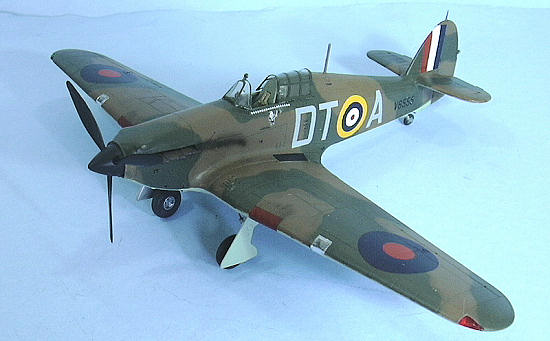 Hasegawa has released just about every version of the Hurricane ever
produced (other than the two-seaters), either in large runs or in limited
editions like this Hurricane Mk. I Trop.
I merely used this kit because it was available at the LHS during the
estate sale of the possessions of a kit collector who has moved on to the
Big Hobby Shop in the Sky, and was priced to sell at $19.95.
It also has the deHavilland prop with the smaller, more pointed
spinner, rather than the bulbous Rotol prop, which was what I needed for
this project. The kit provides decals for two different tropical Hurricanes
and you can see a review I did of this kit earlier in the reviews section of
the site.
Hasegawa has released just about every version of the Hurricane ever
produced (other than the two-seaters), either in large runs or in limited
editions like this Hurricane Mk. I Trop.
I merely used this kit because it was available at the LHS during the
estate sale of the possessions of a kit collector who has moved on to the
Big Hobby Shop in the Sky, and was priced to sell at $19.95.
It also has the deHavilland prop with the smaller, more pointed
spinner, rather than the bulbous Rotol prop, which was what I needed for
this project. The kit provides decals for two different tropical Hurricanes
and you can see a review I did of this kit earlier in the reviews section of
the site.
I dragged the Aeromaster “Early Hurricane Aces of the British Empire
1939-40, Part
| CONSTRUCTION |
There are numerous reviews here of building the Hasegawa Hurricane.
For me, these are the two most important points:
Hasegawa is noted for excellent engineering of their kits, and the
Hurricanes are no exception. The one problem of the kit is that when the
lower wing assembly was designed, it cut straight across through the
underfuselage fabric effect, rather than along a panel line; this means a
modeler must putty the area and sand off carefully. I find that the fact
there is exhaust staining seen on the lower rear fuselage in nearly every
 Hurricane
photo provides the chance to hide this with weathering at the end of
construction.
Hurricane
photo provides the chance to hide this with weathering at the end of
construction.
Additionally, the kit is designed to have the canopy closed. When using the Squadron canopy - which is crucial if you want the canopy opened - a modeler needs to build up the area that would be under the canopy aft of the headrest, to get rid of the noticeable ridge. Checking photos in either of the references noted above makes this easy. Beyond this, if a modeler follows the kit instructions for the variant being created, the result will be an excellent model.
| COLORS & MARKINGS |
Painting:
The instructions in the Aeromaster sheet stated that this airplane
was done in the “B” camouflage scheme, which I freehanded using Xtracrylix
“Dark Earth,” “RAF Dark Green.” and “Sky.”
Since the original airplane was only in service a bit more than 8
weeks, I didn’t “ding” it, but did apply exhaust stains.
As said above, applying stains to the lower rear fuselage covers the
problem of the seam in the middle of the fabric there.
Decals:
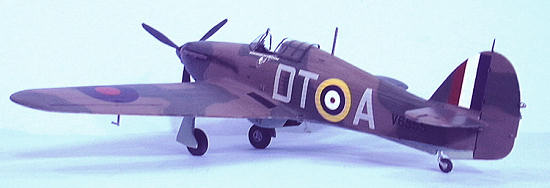
I particularly liked that this sheet had V6555, Tuck’s first
Hurricane that he flew with 257 Squadron, rather than the better-known
V6864. Tuck scored most of his
victories during the time he led 257 in the
| FINAL CONSTRUCTION |
The landing gear was attached along with the prop.
The Squadron canopy was cut free and then the canopy and windscreen
were separated, and attached in the open position.
| CONCLUSIONS |
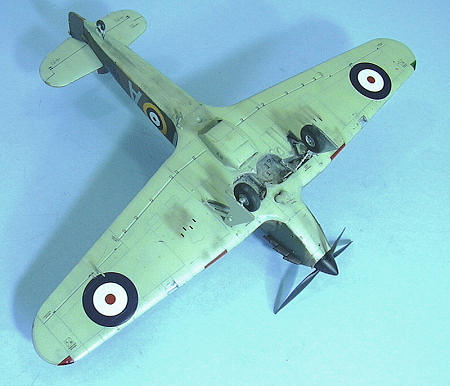 It’s a Hasegawa Hurricane - what’s not to like?
The kit is easy to build, and if you score some of the old Aeromaster
sheets that are still out there to be found at shows or older hobby shops or
on EvilBay, there’s a plethora of markings possibilities.
It’s a Hasegawa Hurricane - what’s not to like?
The kit is easy to build, and if you score some of the old Aeromaster
sheets that are still out there to be found at shows or older hobby shops or
on EvilBay, there’s a plethora of markings possibilities.
Review kit courtesy of my wallet.
May 2009
If you would like your product reviewed fairly and quickly, please contact me or see other details in the Note to Contributors.